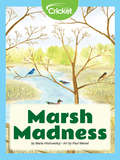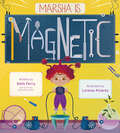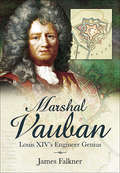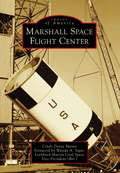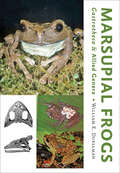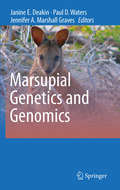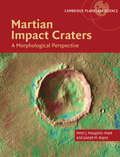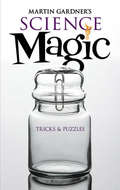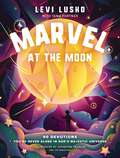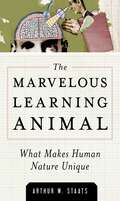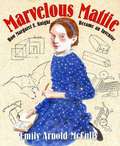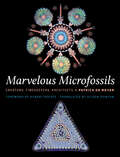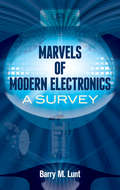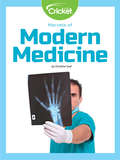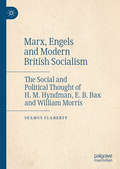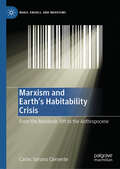- Table View
- List View
Marsh Madness
by Maria HlohowskyjHave you ever gone birdwatching before? Learn about all the different birds that migrate to the Magee Marsh every spring! See all the kinds of birds that make their way to the same spot every year, like warblers, owls, and even ducks!
Marsha Is Magnetic
by Beth FerryIt turns out that the best way to "attract" friends to invite to your birthday is by being yourself in this sweet, STEAM-minded picture book from New York Times best-selling author Beth Ferry. Marsha's birthday is coming up, and she needs to make some friends to invite to her party. She's a little stumped...but a scientist knows how to solve problems: the scientific method! With equal parts creativity, determination, and humor, Marsha sets out to attract as many friends as she can for her birthday bash—what could possibly go wrong? In this hilarious celebration of birthdays, friendship, and ingenuity, Beth Ferry and Lorena Alvarez show readers that the best way to attract friends is to simply be yourself.
Marshal Vauban: Louis XIV's Engineer Genius
by James Falkner&“[A] vivid and well written account of the life of the man who built some of the most magnificent military structures known to man.&”—Clayton Donnell, &“Fortress Archaeologist&” Sebastien Le Prestre, Marshal Vauban, was one of the greatest military engineers of all time. His complex, highly sophisticated fortress designs, his advanced theories for the defense and attack of fortified places, and his prolific work as a writer and radical thinker on military and social affairs, mark him out as one of the most influential military minds of the late seventeenth and early eighteenth centuries. Yet no recent study of this extraordinary man has been published in English. James Falkner, in this perceptive and lively new account of Vauban&’s life and work, follows his career as a soldier from a dashing and brave young cavalry officer to his emergence as a masterful military engineer. And he shows that Vauban was much more than simply a superlative builder of fortresses, for as a leading military commander serving Louis XIV, he perfected a method for attacking fortifications in the most effective way, which became standard practice until the present day. Falkner&’s new study will add significantly to the understanding of Vauban&’s achievements and the impact his work has had on the history of warfare. &“A very enjoyable read for those looking for a good, basic account of Vauban&’s career and his role in the wars of Louis XIV and of fortification more generally. Its usefulness is enhanced by various maps and reproductions of portraits of key characters and of contemporary plans of fortresses.&”—War in History
Marshal Vauban: Louis XIV's Engineer Genius
by James Falkner&“[A] vivid and well written account of the life of the man who built some of the most magnificent military structures known to man.&”—Clayton Donnell, &“Fortress Archaeologist&” Sebastien Le Prestre, Marshal Vauban, was one of the greatest military engineers of all time. His complex, highly sophisticated fortress designs, his advanced theories for the defense and attack of fortified places, and his prolific work as a writer and radical thinker on military and social affairs, mark him out as one of the most influential military minds of the late seventeenth and early eighteenth centuries. Yet no recent study of this extraordinary man has been published in English. James Falkner, in this perceptive and lively new account of Vauban&’s life and work, follows his career as a soldier from a dashing and brave young cavalry officer to his emergence as a masterful military engineer. And he shows that Vauban was much more than simply a superlative builder of fortresses, for as a leading military commander serving Louis XIV, he perfected a method for attacking fortifications in the most effective way, which became standard practice until the present day. Falkner&’s new study will add significantly to the understanding of Vauban&’s achievements and the impact his work has had on the history of warfare. &“A very enjoyable read for those looking for a good, basic account of Vauban&’s career and his role in the wars of Louis XIV and of fortification more generally. Its usefulness is enhanced by various maps and reproductions of portraits of key characters and of contemporary plans of fortresses.&”—War in History
Marshall Space Flight Center (Images of America)
by Cindy Donze MantoMarshall Space Flight Center (MSFC) was carved from the environs of Redstone Arsenal in Huntsville, Alabama, at the height of the Cold War with the former Soviet Union. Originally, the area was a center for cotton production and large mills, but on the eve of World War II, civic leaders sought a US Army initiative that established Redstone and Huntsville Arsenals for the manufacture and stockpile of small solid-fuel rockets and chemical weapons. After World War II, Operation Paperclip brought scientists and engineers from Germany to pursue missile and rocket development at Redstone Arsenal's Army Ballistic Missile Agency (ABMA) and eventually the National Aeronautics and Space Administration (NASA). After establishing the civilian NASA on July 29, 1958, Pres. Dwight D. Eisenhower dedicated the George C. Marshall Space Flight Center on September 8, 1960, to the resolute general, statesman, and "builder of peace." The president concluded, "May this great center be ever worthy of its honored name." Following the Mercury and Apollo programs of the 1960s and early 1970s, MSFC's notable achievements continued with Skylab, Apollo-Soyuz Test Project, Space Shuttle, Spacelab, and the space station. Today, Marshall Space Flight Center, NASA's leading center for propulsion systems and launch vehicles, supports the lunar missions of Project Artemis.
Marsupial Frogs: Gastrotheca and Allied Genera
by William E. DuellmanThe first major synthesis of marsupial frogs, this book is the magnum opus of renowned herpetologist William E. Duellman.This scientific masterpiece reveals many aspects of the lives of marsupial frogs and closely allied genera. Native to Central and South America, these amphibians differ from other frogs in that they protect their eggs after oviposition by either adhering them to the female’s back or placing them in a specialized dorsal pouch (thus the common name, marsupial frog). During mating, the male typically collects the eggs from the female with his feet—often one at a time and always out of water—fertilizes them, and then tucks them into the female’s pouch or attaches them to her back. In some species these eggs hatch as tadpoles, but most emerge as miniatures of the adults. Even among the tadpoles there is remarkable divergence, with some behaving in the typical manner (feeding and metamorphosing), whereas others forego all feeding until they metamorphose.In Marsupial Frogs, William E. Duellman’s synthesis of all that is known about the unique family Hemiphractidae is largely based on decades of his own careful laboratory and field study. He reveals the diversity of exotic color patterns and the frogs' geographic distributions by providing more than 200 photographs, illustrations, and maps. This exceptional tome should find its way into the libraries of serious herpetologists, tropical biologists, and developmental biologists. Included in this book are• A molecular phylogeny of the family Hemiphractidae• A thorough osteological analysis• A review of external morphological features• An overview of the evolution of reproductive modes• A biogeographic synthesis• Keys to genera and species• Diagnosis and thorough description of each species of marsupial frog• Colored physiographic maps depicting species distributions
Marsupial Genetics and Genomics
by Jennifer A. Marshall Graves Paul D. Waters Janine E. DeakinMarsupials belong to the Class Mammalia, sharing some features with other mammals, yet they also possess many unique features. It is their differences from the more traditionally studied mammals, such as mice and humans, that is of greatest value to comparative studies. Sequencing of genomes from two distantly related marsupials, the short grey-tailed opossum from South America and the Australian tammar wallaby, has launched marsupials into the genomics era and accelerated the rate of progress in marsupial research. With the current worldwide concern for the plight of the endangered Tasmanian devil, marsupial genetics and genomics research is even more important than ever if this species is to be saved from extinction. This volume recounts some of the history of research in this field and highlights the most recent advances in the many different areas of marsupial genetics and genomics research.
Martian Aeolian Geomorphology: An Introduction
by Chao Li Zhibao Dong Ping LüThis book covers Martian Aeolian Geomorphology and is organized around three main foci. The first focus is about advancing our understanding of aeolian geomorphology through research on Martian aeolian landforms. Chapters 1 through 4 provide essential knowledge for understanding the aeolian geomorphology of Mars. Among them, Chapters 1 and 2 provide readers with a clear understanding of the significance, scientific status and methodology of the study of aeolian geomorphology on Mars. Chapters 3 introduces the physics of aeolian geomorphology and Chapter 4 presents an overview of Mars. Chapters 5 and 6 are devoted to the Martian atmosphere, and Martian sediments respectively, constituting the dynamic conditions and the material basis for the formation of aeolian landforms, their basic characteristics, the processes that control their formation and evolution, and comparisons with Earth. Chapters 7 and 8 discuss the geomorphological types, morphology and distribution of dunes on Mars, and extract information on the developmental environment and processes that control dune landforms. The second focus of this book concerns the unique characteristics of Martian aeolian landforms. Chapters 9 and 10 provide thorough introductions to several unique Martian aeolian landforms. The third focus is to provide a textbook for graduate students. To facilitate understanding of Martian aeolian landforms and deepen the reader’s comprehension of current aeolian geomorphological theories, we connect the characteristics of various aspects of Martian aeolian landforms with the relevant theories, and especially the classical theories that have stood the test of time. At the same time, we try to present different viewpoints and hypotheses on relevant scientific issues, leaving readers with wide room for innovative thinking. The book’s 12 chapters are ordered to start with an overview of fundamental knowledge (Chapters 1to 4), continue (Chapters 5 to 11) by describing the book’s core content, and conclude (Chapters 12 ) by relating what we believe about Mars to what we know about Earth.
Martian Impact Craters: A Morphological Perspective (Cambridge Planetary Science)
by Peter J. Mouginis-Mark Joseph M. BoyceOur exploration of Mars has revealed a world as fascinating as Earth, with a changing climate, giant volcanoes, former oceans, polar ice caps, and numerous impact craters. This book provides a comprehensive summary of the morphology and distribution of meteorite craters on Mars, and the wealth of information these can provide on the crustal structure, surface geology, climate and evolution of the planet. The chapters present highly illustrated case studies of landforms associated with impact craters to highlight their morphological diversity, using high-resolution images and topographic data to compare these features with those on other bodies in the Solar System. Including research questions to inspire future work, this book will be valuable for researchers and graduate students interested in impact craters (both terrestrial and extra-terrestrial) and Mars geology, as well as planetary geologists, planetary climatologists and astrobiologists.
Martian Summer: My Ninety Days with Interplanetary Pioneers, Temperamental Robots, and NASA's Phoenix Mars Mission
by Andrew KesslerA space enthusiast goes inside mission control with a motley crew of rocket scientists in this &“fascinating journey of discovery peppered with humor&” (Publishers Weekly). The Phoenix Mars mission was the first man-made probe ever sent to the Martian arctic. Its purpose was to find out how climate change could turn a warm, wet planet (read: Earth) into a cold, barren desert (read: Mars). Along the way, Phoenix discovered a giant frozen ocean trapped beneath the north pole of Mars, exotic food for aliens, and liquid water, and laid the foundation for NASA&’s current exploration of Mars using the Curiosity rover. This is not science fiction. It&’s fact. And for the luckiest fanboy in fandom, it was the best vacation ever. Andrew Kessler spent the summer of 2008 in NASA&’s mission control with one hundred thirty of the world&’s best planetary scientists and engineers as they carried out this ambitious operation. He came back with a story of human drama about modern-day pioneers battling NASA politics, temperamental robots, and the bizarre world of daily life in mission control.
Martin Gardner's Science Magic: Tricks and Puzzles (Dover Magic Books)
by Martin GardnerMake an eggshell turn a somersault, spin a coin so that it lands on "heads," teach a bear to climb a string, and perform other acts of scientific wizardry! Martin Gardner, the master of mathematical puzzles, shares more than 80 of his finest magic tricks, teaching children and adults the scientific properties behind water, air, fire, heat, motion, gravity, inertia, friction, electricity, magnetism, sound, and light. Fun and fascinating, the simple maneuvers require only basic everyday props, and those requiring matches, knives, boiling water, and other tricky items are marked with a symbol that lets kids know they'll need assistance from an adult. Helpful drawings illustrate each stunt.
Martin's Hundred
by Ivor Noel-HumeA story of an archaeological excavation near Jamestown, Va. The site has been dated from 1620's. This book talks about finding potsherds, skeletons, buttons and armour. These help to date the site and tell the story of what happened here.
Martini Fundamentals Of Anatomy And Physiology: Applications Manual
by William C. Ober Claire W. Garrison Ralph T. Hutchings Frederic Martini Kathleen WelchThis Applications Manual supplements your textbook and helps you apply the concepts of anatomy and physiology to your daily life. The information it contains will be useful to everyone and especially valuable for those planning a career as a health professional. Has a lot of photographs and illustrations to assist you.
Marvel at the Moon: 90 Devotions: You're Never Alone in God's Majestic Universe
by Levi Lusko Tama FortnerLoneliness among kids is on the rise. In Marvel at the Moon: 90 Devotions: You're Never Alone in God's Majestic Universe, author and pastor Levi Lusko uses illuminating stories, biblical teaching, and eye-opening surprises about outer space to show kids that they're never alone, because God is always with them.The moon is a constant and mysterious presence in our sky! Kids marvel at it, just as adults do, wondering about our big universe. And they'll love learning about the moon and other out-of-this-world discoveries about God's creative cosmos. With insightful, educational, and comforting devotions, kids will discover that God is powerful, He is good, and He will never leave us.Including fun facts and simple action steps, this 90-day devotional journey will help kids tohandle real-life issues such as loneliness, peer pressure, negative emotions, and more;tackle truths about God's creation, learn how our universe fits together in perfect harmony, and discover God's love for His children;learn from courageous people, including Father Abraham, Buzz Aldrin, Neil Armstrong, Katherine Johnson, and many others;dig into interesting space and astronomy facts, plus scientific findings reinforced by the Bible; andfoster a new sense of wonder at God's magnificent creation as they engage with His promises.Despite the conundrums kids may face on earth, they'll learn that God defies gravity and is with them wherever they go!
Marvelous Learning Animal: What Makes Human Behavior Unique
by Arthur W. StaatsWhat makes us human? In recent decades, researchers have focused on innate tendencies and inherited traits as explanations for human behavior, especially in light of groundbreaking human genome research. The author thinks this trend is misleading. As he shows in great detail in this engaging, thought-provoking, and highly informative book, what makes our species unique is our marvelous ability to learn, which is an ability that no other primate possesses. In his exploration of human progress, the author reveals that the immensity of human learning has not been fully understood or examined. Evolution has endowed us with extremely versatile bodies and a brain comprised of one hundred billion neurons, which makes us especially suited for a wide range of sophisticated learning. Already in childhood, human beings begin learning complex repertoires-language, sports, value systems, music, science, rules of behavior, and many other aspects of culture. These repertoires build on one another in special ways, and our brains develop in response to the learning experiences we receive from those around us and from what we read and hear and see. When humans gather in society, the cumulative effect of building learning upon learning is enormous. The author presents a new way of understanding humanness-in the behavioral nature of the human body, in the unique human way of learning, in child development, in personality, and in abnormal behavior. With all this, and his years of basic and applied research, he develops a new theory of human evolution and a new vision of the human being. This book offers up a unified concept that not only provides new ways of understanding human behavior and solving human problems but also lays the foundations for opening new areas of science.
Marvelous Mattie: How Margaret E. Knight Became an Inventor
by Emily Arnold MccullyWith her sketchbook labeled My Inventionsand her father's toolbox, Mattie could make almost anything - toys, sleds, and a foot warmer. When she was just twelve years old, Mattie designed a metal guard to prevent shuttles from shooting off textile looms and injuring workers. As an adult, Mattie invented the machine that makes the square-bottom paper bags we still use today. However, in court, a man claimed the invention was his, stating that she "could not possibly understand the mechanical complexities." Marvelous Mattie proved him wrong, and over the course of her life earned the title of "the Lady Edison." This introduction to one of the most prolific female inventors will leave readers inspired. "Marvelous Mattie" is a 2007 Bank Street - Best Children's Book of the Year. Image descriptions present
Marvelous Microfossils: Creators, Timekeepers, Architects
by Patrick de De WeverTraining a powerful lens on the microscopic wonders of the universe, hundreds of photos, both exquisite and strange, accompany this startling exposé of a secret world invisibly evolving around us for billions of years.Silver Winner of the 2021 IBPA Benjamin Franklin Award for Nature & EnvironmentMicrofossils—the most abundant, ancient, and easily accessible of Earth's fossils—are also the most important. Their ubiquity is such that every person on the planet touches or uses them every single day, and yet few of us even realize they exist. Despite being the sole witnesses of 3 billion years of evolutionary history, these diminutive fungi, plants, and animals are themselves invisible to the eye. In this microscopic bestiary, prominent geologist, paleontologist, and scholar Patrick De Wever lifts the veil on their mysterious world.Marvelous Microfossils lays out the basics of what microfossils are before moving on to the history, tools, and methods of investigating them. The author describes the applications of their study, both practical and sublime. Microfossils, he explains, are indispensable in age-dating and paleoenvironmental reconstruction, which guide enormous investments in the oil, gas, and mining industries. De Wever shares surprising stories of how microfossils made the Chunnel possible and have unmasked perpetrators in jewel heists and murder investigations. He also reveals that microfossils created the stunning white cliffs on the north coast of France, graced the tables of the Medici family, and represent our best hope for discovering life on the exoplanets at the outer edges of our solar system. Describing the many strange and beautiful groups of known microfossils in detail, De Wever combines lyrical prose with hundreds of arresting color images, from delicate nineteenth-century drawings of phytoplankton drafted by Ernst Haeckel, the "father of ecology," to cutting-edge scanning electron microscope photographs of billion-year-old acritarchs. De Wever's ode to the invisible world around us allows readers to peer directly into a minute microcosm with massive implications, even traversing eons to show us how life arose on Earth.
Marvels of Modern Electronics: A Survey
by Barry LuntThis scintillating survey of the major electronic discoveries of the past century -- including static electricity, vacuum tubes, transistors, and television -- focuses on the past forty years of technological innovation. Learn what's "under the hood" of computers, integrated circuits, the Internet, cell phones, GPS, optical fibers, space probes, and other modern wonders. Engaging and mildly technical, this authoritative treatment can be understood by anyone with a high school education and an interest in technology.A brief history of electronics is succeeded by explorations of developments in electrical safety, radar, and deep-space probes. Additional topics include the operation of computers, data storage, and optical fiber communications as well as the electronics behind automobiles and consumer devices. The first four chapters provide background, and the following self-contained chapters may be read in any order. Author Barry M. Lunt, a Professor of Information Technology at Brigham Young University, also provides forecasts for upcoming directions in electronics.
Marvels of Modern Medicine
by Christine GrafIn medicine, machines can be used to take detailed pictures of bones and even to save people’s lives. Read on to learn about the marvelous machines of modern medicine, like the defibrillator, the x-ray machine, and more!
Marx, Engels and Modern British Socialism: The Social and Political Thought of H. M. Hyndman, E. B. Bax and William Morris
by Seamus FlahertyThis book is a reception study of Karl Marx’s and Friedrich Engels’ ideas in Britain during the late nineteenth century and a revisionist account of the emergence of modern British socialism. It reconstructs how H. M. Hyndman, E. B. Bax, and William Morris interacted with Marx and ‘Marxism’. It shows how Hyndman was a socialist of liberal and republican provenance, rather than the Tory radical he is typically held to be; how Bax was a sophisticated thinker and highly influential figure in European socialist circles, rather than a negligible pedant; and it shows how Morris’s debt to Bax and liberalism has not been given its due. It demonstrates how John Stuart Mill, in particular, was combined with Marx in Britain; it illuminates other liberal influences which help to explain the sectarian attitude adopted by the Social Democratic Federation towards organised labour; and it establishes an alternative genealogy for Fabian socialism.
Marxism and Earth's Habitability Crisis: From the Metabolic Rift to the Anthropocene (Marx, Engels, and Marxisms)
by Carles Soriano ClementeThis book argues that as long as capitalism is globally dominant, there must be a crisis of habitability on Earth. Overcoming this crisis is not a matter of technology. Technological strategies need to be adopted to mitigate human impact on Earth, but as long as they are implemented on a capitalist basis the crisis will not be overcome. Unfortunately, this is not fully understood today, and initiatives to confront the crisis based on idealism and positivism flourish everywhere. This makes research into the main epistemological reasons for the misunderstanding of the relationship between the reproduction of capital and the crisis of habitability an urgent task, which is undertaken throughout the book. Such misunderstanding is ultimately related to the old problem of philosophy, the relationship between thought and being. A problem that the crisis of habitability expresses as the insurmountable contradiction between capitalist humans and nature.
Marxism and the Individual
by Cem EroğulThis book attempts to develop a Marxist theory of the human individual. It contends that the standard description of the human as a bio-psycho-social being is fundamentally deficient as it doesn’t specify which of these attributes is the determining one. As long as this is not done, the real nature of humanity cannot be uncovered.
Marxism in the Age of Ecological Catastrophe: Theory and Praxis (Marx and Marxisms)
by Eduardo Sá BarretoMarxism in the Age of Ecological Catastrophe offers a stimulating discussion on the ecological unfeasibility of capitalist society.Divided into three parts, Eduardo Sá Barreto begins by providing a reconstruction of Marx’s theory of value and articulating it into a ecological critique of this society. Part Two surveys key debates between some of today's most representative Marxist ecologists. Part Three explores political approaches, tactical and strategic issues to see whether they align with the gravity of the challenges facing humanity or not.Located at the intersection of the natural and social sciences, Marxism in the Age of Ecological Catastrophe will be of interest to scholars of political science, economics, ecology, climatology, demography, geography, and sociology.
Mary Anning and Paleontology for Kids: Her Life and Discoveries, with 21 Activities (For Kids series)
by Stephanie BearceMary Anning was only 12 years old when she excavated the skeleton of an unknown animal. The discovery of the ichthyosaur was the dawn of a new age of science called paleontology, and Anning became one of the leading experts in the study of dinosaurs. Her discoveries helped lay the groundwork for Charles Darwin's theory of evolution and changed the way scientists understood the past. Unfortunately, as a woman of the 1800s, Anning received almost no recognition for her contributions, which were instead credited to the male naturalists who had purchased her specimens. Author Stephanie Bearce brings Anning's remarkable work to life for young readers with research and projects that allow children to experience hands‑on science as Anning did.Kids will create fossil models in plaster and use tools to extract them, build a Mesozoic diorama of a dinosaur habitat, grow crystals in an eggshell to observe how geodes are formed, and much more!
